
The brown gerygone, previously known as the brown warbler, is a small passerine bird native to eastern coastal Australia. The upper parts of the brown gerygone are a deep olive-grey or olive-brown, while its face and underparts are a much paler grey, cream, or washed-out brown. The tail feathers are dark and may be white-tipped. It is approximately 10 cm in length.
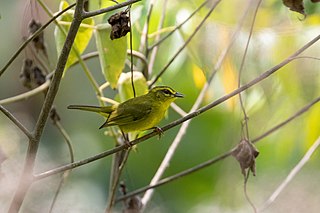
The Cuzco warbler is a South American species of bird in the family Parulidae. Its natural habitats are subtropical or tropical moist lowland forests, subtropical or tropical moist montane forests, and heavily degraded former forest. The bird was split from the golden-bellied warbler.

The grey-hooded bush tanager is a species of South American bird in the tanager family Thraupidae. It is the only member of the genus Cnemoscopus. It is found in Bolivia, Colombia, Ecuador, Peru, and Venezuela. Its natural habitat is subtropical or tropical moist montane forests.

Gerygone, the gerygones or peep-warblers, is a genus of bird in the family Acanthizidae. The genus ranges from Southeast Asia through New Guinea and Australia to New Zealand and the Chatham Islands. Most of the species are found in Australia and New Guinea; only one, the golden-bellied gerygone, has managed to cross Wallace's Line and colonise as far as Thailand, Malaysia and the Philippines.
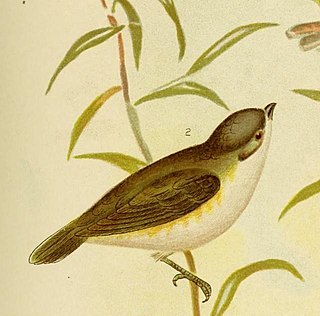
The green-backed gerygone is a species of bird in the family Acanthizidae found in northern Australia and New Guinea. Its natural habitats are subtropical or tropical moist lowland forests and subtropical or tropical mangrove forests.

The rufous-sided gerygone is a species of bird in the family Acanthizidae. It is found in the eastern Lesser Sunda Islands and Kai Islands.

The fan-tailed gerygone is a species of bird in the family Acanthizidae. It is found in New Caledonia and Vanuatu. The Rennell gerygone of the Solomon Islands was formerly considered conspecific, but was split as a distinct species by the IOC in 2021.

The western gerygone is a small, brownish-grey species of passerine bird, which is found in inland and south-west Australia. It is an arboreal, insectivore of open forest, woodland and dry shrubland. It is not currently threatened with extinction.
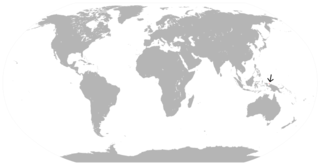
The Biak gerygone is a species of bird in the family Acanthizidae. It is endemic to the islands of Biak and Supiori in West Papua, Indonesia.
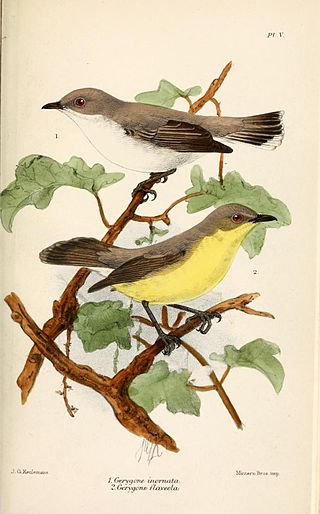
The plain gerygone is a species of bird in the family Acanthizidae. It is found on the islands of Wetar and Timor. Its natural habitats are subtropical or tropical moist lowland forest and subtropical or tropical mangrove forest.

The mangrove gerygone is a species of bird in the Australian warbler family Acanthizidae. The species is also known as the mangrove warbler. The species is thought to form a superspecies with the closely related fan-tailed gerygone of Melanesia and the Australian western gerygone. There are three subspecies of mangrove gerygone, G. l. pallida, found in southern New Guinea, the nominate race G. l. levigaster, which is found from coastal Western Australia to coastal north Queensland, and G. l. cantator, which is found from coastal Queensland to New South Wales. The species is uncommon in New Guinea and has suffered some declines due to mangrove clearances but is not considered threatened by the IUCN.

The white-throated gerygone is a species of bird in the family Acanthizidae. It is found in Australia and Papua New Guinea. Its natural habitats are temperate forests and subtropical or tropical moist lowland forests. Its common names include white-throated warbler, white-throated flyeater, bush canary, and native canary.

The fairy gerygone, previously known as the fairy warbler, is a species of bird in the family Acanthizidae native to New Guinea and Queensland.

The brown-breasted gerygone or treefern gerygone is a species of bird in the family Acanthizidae. It is found in the highlands of New Guinea. Its natural habitat is subtropical or tropical moist montane forests.
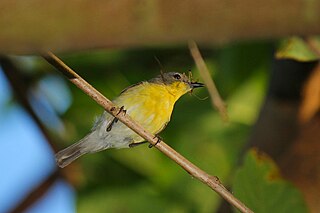
The golden-bellied gerygone is a species of bird in the family Acanthizidae. It is found in Brunei, Indonesia, Malaysia, the Philippines, Singapore, and Thailand. Its natural habitats are subtropical or tropical moist lowland forest and subtropical or tropical mangrove forest.

The dusky gerygone is a species of bird in the family Acanthizidae. It is endemic to coastal central and northern areas of Western Australia.

The golden monarch is a species of passerine bird in the family Monarchidae found in New Guinea. Its natural habitats are subtropical or tropical moist lowland forests and subtropical or tropical moist montane forest. The golden monarch displays marked sexual dimorphism, the male a striking golden colour with black mask, wings and tail, the female a golden or golden-olive colour. Both bear a characteristic 'teardrop' white pattern below the eye.

The large-billed gerygone is a species of bird in the family Acanthizidae found in northern Australia and New Guinea.
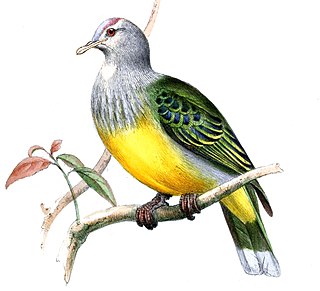
The Raiatea fruit dove is a species of bird in the family Columbidae. It is endemic to the Society Islands in French Polynesia. Although first named to science in 1853, this fruit dove was evidently discovered 30 years earlier, by René Primevère Lesson (1794–1849), while serving as naturalist aboard La Coquille. It was formerly considered a subspecies of the grey-green fruit dove but was split as a distinct species by the IOC in 2021. Its natural habitat is subtropical or tropical moist lowland forests.
The Rennell gerygone is a species of bird in the family Acanthizidae. It is found on Rennell Island. It was formerly considered a subspecies of the fan-tailed gerygone, but was split as a distinct species by the IOC in 2021.




















